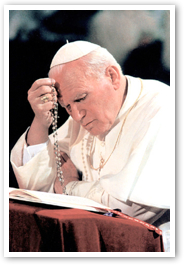Lepanto and the Holy Rosary
- FATHER GEORGE W. RUTLER
Having had father, uncles and cousins in combat on the high seas for our country, I may have been a disappointment to the family line, being prone to seasickness when doing anything more adventurous than rowing in college.
 I was taken aboard a Liberty ship in World War II as an infant, but only long enough to be shown to my father and have my diaper changed. So I lay claim to having been on a ship in wartime, although my service was an inferior one.
I was taken aboard a Liberty ship in World War II as an infant, but only long enough to be shown to my father and have my diaper changed. So I lay claim to having been on a ship in wartime, although my service was an inferior one.
Naval historians still contend over which was the largest maritime engagement: Salamis in 480 B.C., Jutland in 1916, the Philippine Sea or Leyte Gulf in 1944, but Lepanto in October of 1571 ranks with them in historical importance. As it saved Christian civilization for a while, the Battle of Lepanto may have been the most decisive, and since it was done totally by sail and oars, it was a most breathtaking example of naval skill. Pope St. Pius V organized the battle and, having been supernaturally informed of the victory before human messengers brought news, he gave us the Feast of Our Lady of Victory. The pope's weapon was the Holy Rosary, which is why the month of October is dedicated to this form of prayer — the most celestial, save for the Eucharist itself.
While pious belief attributes the invention of the Rosary to Saint Dominic in his struggle against the Albigensian heretics who denied the true divine and human natures of Christ, it goes back earlier, to when those monastic lay brothers known as conversi, not being able to read, used it as a substitute for the regular recitation of all 150 psalms. Originally, the Rosary consisted of just the Our Father (which is why the lane in London where Rosaries were made is still called "Paternoster Row"). During the twelfth century, the first half of the Hail Mary was added, and the second half was added somewhat later. Gradually, meditation on various Mysteries was encouraged. Saint John Paul II enriched the Rosary with the Luminous Mysteries. It is called a Rosary because it is a rosarium, or "rose garden," and it offers God prayer made fragrant with the words of St. Elizabeth, the Archangel Gabriel, and Christ himself.
Our civilization now is threatened not only by the heretical forces that engaged the Christians at Lepanto, but also by the more subtle forces of atheism, euphemistically called "secularism," that have insinuated themselves into our civil institutions. In 1985, a priest was deeply moved to see Saint John Paul II praying the Rosary humbly on his knees. He said, "I became aware of the density of the words of the Mother of Guadalupe to St Juan Diego: 'Don't be afraid, am I not perhaps your mother?'" From that moment the priest has never failed to recite all fifteen decades of the Rosary each day, even now that he is Pope Francis.
 This is Meaghen Gonzalez, Editor of CERC. I hope you appreciated this piece. We curate these articles especially for believers like you.
This is Meaghen Gonzalez, Editor of CERC. I hope you appreciated this piece. We curate these articles especially for believers like you.
Please show your appreciation by making a $3 donation. CERC is entirely reader supported.

Acknowledgement
Father George W. Rutler. "Lepanto and the Holy Rosary." From the Pastor (October 12, 2014).
Reprinted with permission of Father George W. Rutler.
The Author
 Father George W. Rutler is the pastor of St. Michael's church in New York City. He has written many books, including: The Wit and Wisdom of Father George Rutler, The Stories of Hymns, Hints of Heaven: The Parables of Christ and What They Mean for You, Principalities and Powers: Spiritual Combat 1942-1943, Cloud of Witnesses — Dead People I Knew When They Were Alive, Coincidentally: Unserious Reflections on Trivial Connections, A Crisis of Saints: Essays on People and Principles, Brightest and Best, and Adam Danced: The Cross and the Seven Deadly Sins.
Father George W. Rutler is the pastor of St. Michael's church in New York City. He has written many books, including: The Wit and Wisdom of Father George Rutler, The Stories of Hymns, Hints of Heaven: The Parables of Christ and What They Mean for You, Principalities and Powers: Spiritual Combat 1942-1943, Cloud of Witnesses — Dead People I Knew When They Were Alive, Coincidentally: Unserious Reflections on Trivial Connections, A Crisis of Saints: Essays on People and Principles, Brightest and Best, and Adam Danced: The Cross and the Seven Deadly Sins.




